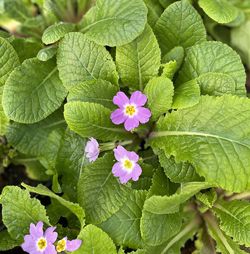Hydrangea
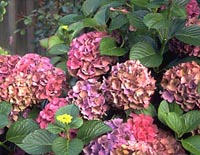
Climbing Hydrangea
The name Hydrangea, means “water vessel,” given for its cup-shaped seed capsules. A genus of diverse forms, Hydrangeas are commonly found throughout Asia, from the Himalayas to Taiwan and Japan, with the exception of 2 species, Hydrangea arborescens and Hydrangea quercifolia, which are native to North America. Easily cultivated, this shrub’s lush deciduous leaves are best suited to loose, moist soil in the shade of tall trees or on the north side of the house.
Hydrangea anomala ssp petiolaris (T-0015)
Each $22.50

Don’t be put off by the name; this climbing Hydrangea features broad white flower heads, reddish bark, and the glossiest leaves. It produces self-clinging, aerial roots that easily attach to just about anything: pergola, wall, fence or tree, and may need 10 years to reach its full height, but patience pays off with this spectacular deciduous specimen. Meanwhile, enjoy it on a north wall with an understory of Corydalis ‘Blue Panda’ and Geranium ‘Ann Folkard’. Large Band.
Blooms June–July
Size: 60' 0" – 80' 0" high x 0" & spreading wide.
Hardy to zone 5.
Looking to add some botanical razzle-dazzle to a hohum shady recess? This mighty variegated vine, introduced by astute horticulturist Dan Banarcik of Chanticleer Gardens, may be your solution. Lustrous deeply serrated dark green leaves flaunt broad golden yellow margins in the spring, which later mellow to a refreshing chartreuse as the weather warms. Iced with lacy white flowers in early summer, the bright deciduous foliage makes a splendid cloak for faithful ‘Firefly’s upright climbing habit. Large Band. (pp#11,038)
Blooms June–July
Size: 30' 0" high x 0" & spreading wide.
Hardy to zone 5.
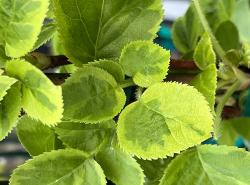
Looking to add some sky-reaching razzle-dazzle to a shady ho-hum recess? This mighty, variegated climber may be your solution. Illuminated by lambent golden-yellow margins in the spring that adopt fresh creamy-chartreuse shades as the weather warms, the serrated heart-style dark green leaves serve as a gleaming deciduous backdrop for airy sparkling white lacecaps. Clinging with aerial rootlets, ‘Miranda’s versatile bushy profile develops layered-looking horizontal branches, showcases attractive exfoliating reddish brown bark in winter and cherishes rich, moist well-drained soil. Medium Band.
Blooms June–July
Size: 30' 0" – 40' 0" high x 0" & spreading wide.
Hardy to zone 4.
This sterling cultivar's lustrous, toothed greenery is dappled with choice cream-colored lacy blooms. A luminous standout amid eastward shadows, ‘Skylands Giant’ was selected at the New Jersey Botanical Garden in Skylands for its exceptionally large showy lacecaps, which feature soft-looking centers of tiny fertile flowers ringed by loosely arranged, larger white sterile florets. Large Band
Blooms June – July
Size: 30' 0" high x 0" & spreading wide.
Hardy to zone 4.
Hailing from the Philippines and Taiwan, this climbing evergreen Hydrangea is seldom seen in cultivation. Rambling, red-hued, hairy stems sport pairs of lustrous elongated leaves, which are so exquisite, it’s easy to wait for the vine to establish itself and produce its intriguing rounded buds and pretty lacy white flowers. A stellar choice for a mild maritime climate or a sheltered wall.
Large Band.
Blooms August
Size: 25' 0" – 30' 0" high x 0" & spreading wide.
Hardy to zone 7.

Another rare evergreen climbing form, this vigorous Mexican Hydrangea is quite handsome with its leathery, very shiny, laurel-like dense growth of leaves. Pale green bracts enclose the flower bud, opening to reveal elegant, domed heads circled by a ring of large, white florets. It’s slightly tender, so let it climb over a sheltered wall.
Blooms July–mid-August
Size: 30' 0" high x 0" & spreading wide.
Hardy to zone 7.
Hydrangea

Climbing Hydrangea
The name Hydrangea, means “water vessel,” given for its cup-shaped seed capsules. A genus of diverse forms, Hydrangeas are commonly found throughout Asia, from the Himalayas to Taiwan and Japan, with the exception of two species, Hydrangea arborescens and Hydrangea quercifolia, which are native to North America. Easily cultivated, this shrub’s lush deciduous leaves are best suited to loose, moist soil in the shade of tall trees or on the north side of the house.
In cultivation for more than 60 years, this robust sumptuously colored German cultivar is still considered one of the finest mopheads. Pale green stems and bold, waxy and somewhat wrinkled medium green foliage sculpt its dense, small-statured globular form. A vivacious deep rosy red bedazzles each alluring rounded flower, defined by attractively spaced individual florets with pointed tips and upturned edges. Surprisingly sun tolerant, the red-tinged foliar margins echo the bloom hues, while autumn brings a suffusion of dark maroon to the entire leaf.
‘Glowing Embers’ is second-to-none for the smaller garden and promises to parade its marvelous hues for several months if a soil pH of 6.5 is maintained.
Blooms July – August.
Size: 3' 0" – 4' 0" high x 3' 0" – 4' 0" wide.
Hardy to zone 6.
Hydrangea arborescens ‘Annabelle’ (S-0048)
Each $16.25
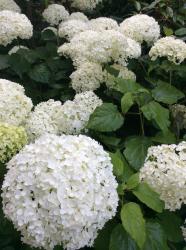

‘Annabelle’ is “unabashedly the queen of the Hydrangea arborescens cultivars”, wrote esteemed horticulturist, Michael Dirr, and we wholeheartedly concur! Named and introduced by the late great plantsman, J. C. McDaniel, this superior native Hydrangea was first found along a wooded trail over 100 years ago in the small town of Anna, Illinois. The lovely spectacle of immense, foot wide pure white snowballs with closely clustered sepals, concealing fertile flowers and thick celery-colored stalks with broad mint green serrated leaves, is a cool antidote to the stickiest summer day. Steeped in old-fashioned feminine appeal, ‘Annabelle’ luxuriates as a dense dramatic specimen next to Deutzia ‘Nikko’ and Phlomis ‘Amazone’.
Blooms August–October
Size: 3' 0" – 6' 0" high x 4' 0" – 6' 0" wide.
Hardy to zone 4.
Discovered in 2008 and newly introduced, this spectacular native cultivar sprung up as a chance seedling in a Pipersville, PA garden. ‘Haas’ Halo’ premiers massive, 12 in. wide lace-caps with up to 50 good-sized sterile florets hoisted above an upright deciduous foundation, whose strong sturdy stems easily support the snowy-white extravaganza. Large, round, pointed leaves imparting bluish overtones compose a leathery green foil for the magnificent flowers that sustain a comely dried presence some 6 months after they’ve stopped blooming. Though the precise lineage remains uncertain, its stalwart demeanor is known to tackle heat, humidity and drought as well as enliven just about any planting bed. (PPAF)
Blooms June–August
Size: 3' 0" – 5' 0" high x 3' 0" – 5' 0" wide.
Hardy to zone 3.

An elegant deciduous mainstay for dappled shade or north-facing sites, this magnificent large rounded Hydrangea headlines good-sized bluish purple lace caps and big ovate-shaped dark green foliage that imparts a velvet-soft tropical aspect. Pronounced knob-like deep rose-hued buds appear early, but wait ’til late summer to unfurl an iridescent delicacy of dense pale blue heads ringed with serrated mauve florets. Adored by bees, fabulous in dried arrangements and highly responsive to pruning, show-stopping ‘Villosa’ guarantees long lasting end-of-the-season grandeur.
Blooms August–October
Size: 6' 0" – 8' 0" high x 6' 0" – 8' 0" wide.
Hardy to zone 6.
Hydrangea aspera ‘Rocklon’ (S-0421)
Each $16.50

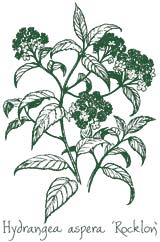
Large pink clouds of buds and pinkish bronze, downy new growth bring a soft look to this noble, rarely cultivated Hydrangea. Mounted on stout fuzzy stems, wide, hairy serrated foliage, with red-hued petioles, provides a graceful deep green foil for the enormous mauve lacecaps ringed by white bracts. Adequate water and bright shade will ensure ‘Rocklon’s prosperity, while Corydalis and Stylophorum diphyllum offer contrasting texture beneath.
Blooms August–mid-November.
Size: 10' 0" high x 8' 0" wide.
Hardy to zone 7.
Paying homage to its late Dutch creator, this lovely, reliable lacecap is closely allied to Hydrangea aspera, a much larger relation. Borne on new wood, big acorn-shaped green buds unfurl a prolific late season parade of soft-looking, fertile bluish lavender flowers surrounded by sterile 4-sepaled white blooms, some infused with the palest blue. Somewhat fuzzy, slender-pointed and finely serrated matte green leaves cloak the medium-sized foundation that’s well-suited for smaller-scaled gardens. Partial shade plus organic-laden, adequately moist soil ensure vigorous growth and ethereal long-lasting floral effects. (pp#21,991)
Blooms July–September
Size: 2' 0" – 4' 0" high x 2' 0" – 4' 0" wide.
Hardy to zone 6.
Superior cold hardiness and guaranteed blossoms give you good reason to invite this plucky small-sized Hydrangea into your planting bed. Since the buds are formed on new wood, the amazing bounty of 6 in. wide, buxom blue mop-heads promises to unfold each summer, regardless of the previous winter’s severity. Well-formed branches and neat, serrated, broad deep green leaves bolster the long-lasting flowers that retain their opulent coloration for weeks and look classy in cut arrangements. Second-to-none where space is a premium, ‘All Summer Beauty’ requires less winter protection than most macrophylla, transmutes buttery-yellow fall color and makes a flower-laden addition to foundations or patio containers.
Blooms June–September
Size: 3' 0" – 4' 0" high x 3' 0" – 4' 0" wide.
Hardy to zone 5.
Hydrangea macrophylla ‘Blue Wave’ (S-0302)
Each $16.25
This choice lacecap Hydrangea deserves center stage, where its lovely broad flowers, in shades of lilac to bright blue, can create a colorful splash. Brushed with streaks of claret as they mature, the blossoms are still alluring in November, and if picked at the right time will dry to an exquisite silvery blue. The robust handsome foliage often displays a glossy surface plus burgundy-hued margins as it cloaks red-speckled green branches. ‘Blue Wave’ is irresistible next to Philadelphus ‘Belle Etoile’, while golden-leafed Carex skirts below.
Blooms mid-August–November
Size: 5' 0" – 6' 0" high x 4' 0" wide.
Hardy to zone 6.
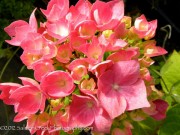
Bred nearly 70 years ago, this vivid, bright cobalt blue mophead is coveted by both florists and landscapers. Overlapping, white-eyed cupped florets mature to pure blue, taking on a flatter appearance, while the large gorgeous blooms later exhibit rich plum hues dappled with smoky blue tinges.
Second-to-none for cutting and drying, the lavish flowers can last through October, festooning a medium-sized, coarse textured shrub whose dark green, maroon edged leaves transmute coppery wine autumnal shades. Euphorbia ‘Limewall’s chartreuse floral bracts create a flashy union.
Blooms July–October
Size: 3' 0" – 4' 0" high x 5' 0" wide.
Hardy to zone 5.
Boasting a plethora of late blooming, bold, bright crimson mopheads, this delectable small-sized Hydrangea originated in Wadenswil, Switzerland. The nonoverlapping sepals crowd onto a compact 4 to 5 in. domed cluster, enhanced by fuzzy looking, prominent fertile flowers.
Well-suited for the front of the border, a patio or a container, ‘Hörnli’s handsome, red-rimmed and toothed, matte green leaves cloak a neat vigorous shrub that easily nestles into a tighter spot, never needs pruning and promises to gratify.
Blooms August – October.
Size: 20" – 2' 0" high x 2' 0" wide.
Hardy to zone 6.
Hydrangea macrophylla ‘Horcos’ (S-0849)
Each $15.25
A 2016 introduction from Dresden, Germany, ‘Horcos’ fashions large domed flowers whose semidouble dark reddish pink florets mature with prominent creamy-white eyes. Flaunting nearly twice as many florets as other mopheads, the unique bicolored blooms stage a breathtaking richly hued presentation all summer long atop strong, thick green stems and lusty, broad serrated greenery. This average-sized floriferous Hydrangea can be massed, planted as a specimen in a mixed border or blanketed beneath by a carpet of white-blooming Geranium ‘St. Ola’. Alkaline soil promotes warm rubescent shades while neutral and acid sites will produce either blue or violet-hued blossoms. (pp#27,110)
Blooms June–September
Size: 3' 0" – 4' 0" high x 4' 0" – 5' 0" wide.
Hardy to zone 6.
While this enticing AGM winner was discovered in Lanarth, Cornwall and similar-looking white lacecaps can be found growing in Japan, its precise origin still remains somewhat of a mystery. Poised above finely serrated broad pale green leaves and unspeckled green stems, irregularly spaced white-as-snow florets perform a lacy dance around medium blue or lilac-colored fertile flowers. Full sun exposures (when accompanied by even moisture), sea side abodes and poor soil seldom impede its shapely habit from displaying a wealth of elegant blooms, which make superb porcelain-hued additions to dried arrangements.
Blooms July–September
Size: 3' 0" – 5' 0" high x 3' 0" – 5' 0" wide.
Hardy to zone 6.

The unusual foliage of this smaller statured Hydrangea will surely bring a “wave” of interest to a shady garden spot. Each leaf is uniquely marked: some are porcelain to cream with lemon yellow margins. Others are green, ranging from emerald through mint to chartreuse. The lacecap flowers can vary in color as well, all the way from white to mauve to blue.
Blooms June–August.
Size: 4' 0" – 5' 0" high x 4' 0" wide.
Hardy to zone 6.
Broad serrated mint green leaves, artfully bordered or otherwise splashed with porcelain white, give you good reason to grow this moderately sized dome-shaped Hydrangea. Viewed from a distance, the variegated foliage translates to soothing olive-hued tones, effectively creating a lush first-rate oasis in the midst of deep greens and finer textured plants. The classy lacecaps, which sport tiny fertile deep gentian blue florets surrounded by large sterile pale blue petals, are the icing on the cake. Well-suited for gardens where space is limited, �Maculata� prospers in dappled light and well-drained, somewhat moist soil.
Blooms June–August
Size: 3' 0" – 4' 0" high x 4' 0" – 5' 0" wide.
Hardy to zone 6.
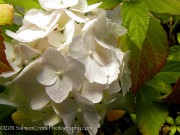
Gracing gardens for an entire century, this vintage French glamor queen parades quantities of large, pure white flower clusters. The rounded mopheads include tightly packed serrated florets, which eventually open wide and push up against one another to produce a frilly feminine silhouette.
Blooming on both old and new wood, and appreciating protection from hot sun, the stylish blossoms bounce back after a rain, unfurl until late in the season, and make unparalleled cut flowers, fresh or dried, while showcasing soft pink and lime-green brush strokes as they age.
The tall robust frame, supported by unspotted stems and smooth, notched glossy green foliage, can be situated along a sheltered shady garden wall or the north side of a house.
Blooms June – August.
Size: 6' 0" high x 6' 0" wide.
Hardy to zone 5.
Hydrangea macrophylla ‘Masja’ (S-0875)
Each $16.25
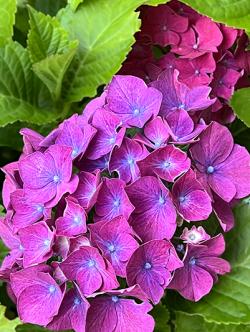
Hoisted aloft by a trim lustrous foil of broadly-ovate dark green foliage, the large close-knit ball-shaped mop-heads flash vibrant reddish magenta colors that slowly develop mulled metallic shades. Wowing floral artists and garden visitors alike, ‘Masja’s long-lasting flowers are big on drama, while its snug mid-sized profile is well-suited for smaller gardens, and can be utilized as a low hedge or featured as a bold container subject. Acidic conditions will cause the blooms to err towards blue-violet.
Blooms July–September
Size: 3' 0" – 4' 0" high x 3' 0" – 4' 0" wide.
Hardy to zone 6.
Widely acclaimed in many gardening circles as one of the best Hortensias, this compact eye-catching Hydrangea sports a deciduous medium growth habit, lustrous dark green elliptical leaves and big colorful frilly mopheads. The close-knit midsummer flowers are defined by large prominently serrated sepals and opulent prismatic shades that range from yellowish green, deep blue and royal purple to pink, depending on the soil pH. Long lasting, plentiful, ideal for bouquets, fresh or dried, and intensely pigmented, ‘Mathilda Gutges’s blooms promise to please.
Blooms July–September
Size: 4' 0" high x 3-1/2' – 4' 0" wide.
Hardy to zone 6.
Hydrangea macrophylla ‘Nigra’ (S-0827)
Each $15.25
Named for its lustrous, stout ebony-infused deep purple stems, this arresting E. H. Wilson introduction received an RHS First Class Certificate in 1895 and has been popular ever since. Large, plush white-veined bright green leaves garb the undemanding rounded profile, while late season creamy white buds develop into speckled mop-heads that range from rosy mauve to blue, depending on the pH. Grateful for a well-composted mulch and shelter from extracold winter weather, ‘Nigra’ can be planted in eye-catching drifts or as a deciduous specimen in a mixed border.
Blooms June–August
Size: 4' 0" – 6' 0" high x 4' 0" – 6' 0" wide.
Hardy to zone 6.
This compact lacecap Hydrangea deserves center stage, where its broad, light blue flowers and dense green foliage can create a colorful splash. Handsome and verdant, the glossy leaves, which are narrower than those of the species, display a tasty reddish plum hue in late summer and fall. A drift of ‘Blue Billow’ is irresistible next to Philadelphus ‘Innocence’, while golden-leafed Hakonechloa skirts below.
Blooms June–August.
Size: 4' 0" – 5' 0" high x 4' 0" wide.
Hardy to zone 6.
A starry cascade of layered sterile florets on long slender pedicels and small round fertile flowers comprises the softly domed white heads, each shaped like a unique hybrid between a lace-cap and a mop-head. Delivering fluid illuminated accents similar to exploding fireworks, and a repeat autumn bloom, the 12 in. wide gossamer-style flowers are set against large, gleaming dark green deciduous leaves with serrated margins and a waxy finish. Well-known in its Japanese homeland, though rarely offered here, this phenomenal Hydrangea makes an enduring artful choice for the shrubby border, a dynamic sweep or a big terracotta pot.
Blooms July–October
Size: 3' 0" – 5' 0" high x 3' 0" – 5' 0" wide.
Hardy to zone 5.
Hydrangea macrophylla ‘Soeur Thérèse’ (S-0863)
Each $15.25
A refined beacon of long-lasting loveliness, large, rounded pure white mop-heads house slightly lax florets that transmute chartreuse tones coupled with red streaks as they age. Well-loved in Britain since the 1950s, this attractive tightknit deciduous Hydrangea bears upright slender stems garbed in winsome ovate and serrated dark green leaves. Easily grown ‘Soeur Thérèse’ craves protection in cold winter locales, and lends a fresh classic touch to patios, containers, formal or informal plantings plus fresh and dried arrangements.
Blooms July–September
Size: 4' 0" – 6' 0" high x 5' 0" – 6' 0" wide.
Zone 7b.
Hydrangea paniculata ‘Limelight’ (S-0612)
Each $17.50
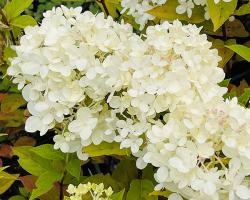
An awe-inspiring beauty whose blooms first open in creamy white elegance, transition to lime-green until fall, and finally turn deep pink, this vigorous Dutch cultivar deserves to be in the limelight. Strong, upright stems cloaked with handsome greenery shoulder the elegant, cone-shaped trusses, which impart a crisp, refreshing sophistication to the shrubby border or a bouquet. (PP#12,874)
Blooms late July–September.
Size: 6' 0" – 8' 0" high x 6' 0" – 8' 0" wide.
Hardy to zone 4.
Selected by plant breeder, Dr. Johan Van Huylenbroeck and named after a Flemish children's super hero, this fantastic recently introduced Hydrangea develops into a sturdy fast growing deciduous shrub with broad deep green veined leaves and strong compact branches that proudly uphold a marvelous action-packed floral display. Large conical heads, emerging pure white and gradually broadcasting rosy red shades in late summer, make exquisite additions to cut arrangements, fresh or dried, and assert long lasting loveliness, even to a frosty midwinter landscape.
Hardy, adaptable and easily pruned for smaller garden spaces, 'Mega Mindy' looks valiant as a coarsely textured specimen along a woodland's edge amid swaths of fine bladed grasses like Sesleria and Pennisetum. (pp#23,070)
Blooms early July–October
Size: 5-1/2' high x 4-1/2' wide.
Hardy to zone 3.
Hydrangea paniculata ‘Pink Diamond’ (S-0420)
Each $17.50
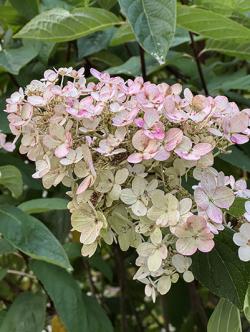
An upright and rounded, compact cultivar, this exceptional deciduous shrub arose from a 1980s selection of Hydrangea ‘Unique’ seedlings. Amid handsome, ovate dark greenery, ample pink buds unveil magnificent, dense, creamy-white panicles poised on staunch red-tinged stems. The dramatic progression of color begins as pink hues develop at each flowers base and gradually darken toward its tip, saturating the entire blossom with antique deep rose shades. Late-blooming ‘Pink Diamond’s grand textural profile can be planted, either singularly or massed, plus added to hedges, mixed borders or open woodland gardens, while its posh pyramidal blooms bestow winter interest and make fantastic dried or fresh cut flowers.
Blooms July–October
Size: 6' 0" – 8' 0" high x 5' 0" – 7' 0" wide.
Hardy to zone 5.
Hydrangea paniculata ‘Silver Dollar’ (S-0876)
Each $17.50
Carefully selected by Dutch plantsman Peter Zwijnenburg, this compact AGM champ puts on the ritz as posh tightknit creamy-white trusses first unfurl with greenish tones, then develop a pink blush in late summer. Perched upon staunch dark crimson-brown stalks and pointed deep greenery, the large broadly-rounded conical heads sport mostly fertile flowers, which lend luminous accents to fresh and dried arrangements. ‘Silver Dollar’s undemanding well-branched habit makes a sterling specimen for smaller gardens, affording a long-blooming season plus textural allure.
Blooms July–October
Size: 5' 0" high x 5' 0" wide.
Zone 4b/5.

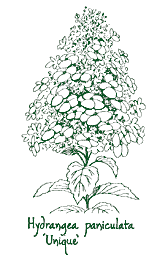
Left to its own designs, this vigorous Hydrangea has a natural upright and arching form, but it also responds well to pruning, making ‘Unique’ an effective choice where space is scarce.
The immense flower heads are spectacular and abundant, and true to name are unique in shape, being quite broad at the base and bluntly rounded at the tip. They begin the season a creamy white and gradually darken to a buff pink.
Blooms early July–October
Size: 10' 0" high x 8' 0" wide.
Hardy to zone 3.
Hydrangea quercifolia ‘Alice’ (S-0323)
Each $16.75
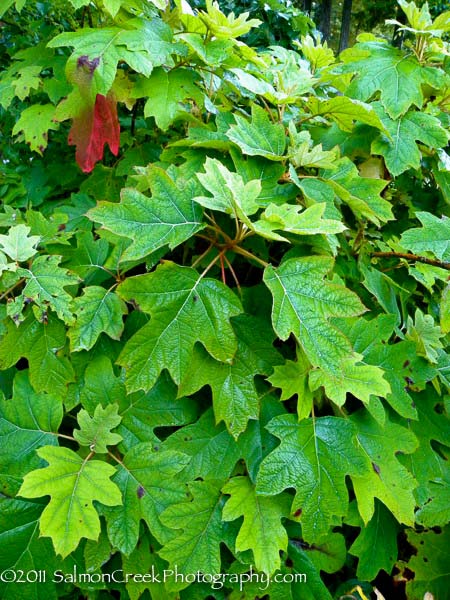
We have Mike Dirr to thank for this vigorous selection. Tall and fast growing, ‘Alice’ displays large, very delicate, lacy looking white flower heads, and the show continues when the broad green oak-shaped leaves turn deep carmine in autumn. For contrast, try planting an understory of Persicaria ‘Red Dragon’.
Blooms July–September.
Size: 10' 0" – 12' 0" high x 8' 0" – 10' 0" wide.
Hardy to zone 5.
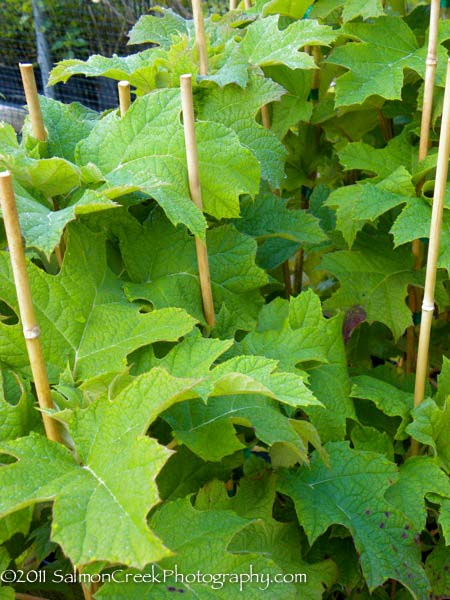
Yet another first-class shrub introduced by esteemed horticulturist, Michael Dirr, this steadfast smaller-sized cultivar commands our attention. The 6 in. long, upright flowers house creamy white sepals, which darken to a luscious wine-red hue as they mature and make exceptional fresh or dried cut flowers, maintaining their rich hues. Ideal as a stand-alone or massed, easy-to-grow ‘Amethyst’ sports handsome, large coriaceous leaves with a spectacular fall showing of burgundy shades.
Blooms July – September.
Size: 5' 0" – 6' 0" high x 5' 0" – 6' 0" wide.
Hardy to zone 5.
Hydrangea quercifolia ‘Queen of Hearts’ (S-0805)
Each $16.75
Recently released by the National Arboretum’s highly touted shrub breeding program, this colorful ‘Snow Queen’ and ‘Pee Wee’ hybrid was selected for its long lasting profusion of huge upright conical white blooms and the antiqued deep pink tones they transmute when they mature. Even without the extravagant 9 in. flowers, ‘Queen of Hearts’s rounded medium statured frame can be successfully utilized in shrubby borders or planted in drifts, where its typical Oak Leaf foliage vaunts dashing textural accents and rich rubescent fall colors.
Blooms July–October
Size: 6-1/2' high x 6' 0" – 8' 0" wide.
Hardy to zone 5.
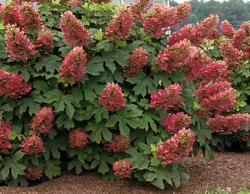
Easily slipped into a diminutive spot, this compelling smaller statured beauty sprung from a 1998 U.S. National Arboretum cross between ‘Snow Queen’ and ‘Pee Wee’. Fabulous 9 in. upright flowers, which open white but quickly transmute pale pink and eventually deeper rose hues, dress up a more petite, compact rounded carriage. Broad, lobed deciduous leaves are dark green in summer and mahogany-tinted come autumn. A peerless companion for fine textured plants such as Spiraea ‘Ogon’ or Sarcococca hookeriana var. humilis, ‘Ruby Slippers’s attractive low silhouette can be ushered to the foreground, planted en masse or utilized as a hedge.
Blooms July–September
Size: 3-1/2' high x 5' 0" wide.
Hardy to zone 5.

Sarah Sikes deserves a round of applause for this low growing Oak Leaf Hydrangea. Hailing from Alabama, it’s half the size of most quercifolias, rendering it a mainstay in the smaller garden. Lobed and closely set, the handsome broad foliage shows off abundant ivory-colored conical blooms. Surround with leaves of like shapes such as Anemone and Kirengeshoma to complement ‘Sikes Dwarf’s unparalleled foliar texture.
Blooms July–August
Size: 3' 0" high x 4' 0" wide.
Hardy to zone 5.
Hydrangea quercifolia ‘Snow Queen’ (S-0201)
Each $18.00
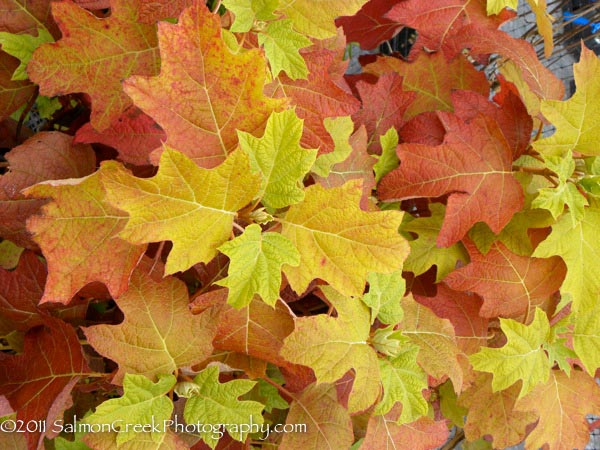
Though its name might make you think otherwise, this hardy shrub also showcases variable earth tones. Its 8 in. long panicles of white flowers, which later take on a pinkish hue, stand out like snow against the beautiful exfoliating cinnamon-brown bark and large Oak-like dark green leaves that turn reddish purple in autumn. Undemanding ‘Snow Queen’ offers a fantastic fall display alongside Panicum ‘Warrior’ with its contrasting form and similar colors.
Blooms July–August
Size: 4' 0" – 6' 0" high x 6' 0" wide.
Hardy to zone 5.
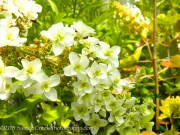

It was a fortuitous moment when Hydrangea enthusiast Eddie Aldridge and his father happened upon this sumptuous Hydrangea in the woodlands of Jefferson County, Alabama. Premiering enormous, 15 in. long white panicles that can extend upward, outward or pendulously, the coarse textured, leathery anchor of large, Oak-like foliage burnishes deep burgundy come fall and stays intact well into December. The distinctive, two-toned double-petaled effect is created when numerous tiered sepals initially open white, while below the older ones develop dark dusty-pink shades with age. ‘Snowflake’s blossoms unfurl a little later and seem to last longer than the single-flowering quercifolia plus Michael Dirr considers them to be the most beautiful of the sterile-blooming cultivars.
Blooms late July–September
Size: 6' 0" – 8' 0" high x 6' 0" – 8' 0" wide.
Hardy to zone 5.
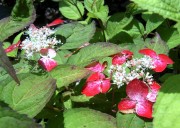
Beni translates “red” in Japanese, and red, specifically a darkly imbued red lacecap is what this small rounded shrub delivers. Originally collected from a wild clone, its graceful form cushions dainty flowers that first emerge blushed white and gradually deepen to rubescent shades, the rich, stop-in-your-tracks color persisting on the sepals well into autumn. With cool green leaves and ardent inflorescences, ‘Beni’ is a dynamic choice for a tight space.
Blooms mid-July–September.
Size: 4' 0" high x 4' 0" wide.
Hardy to zone 6.
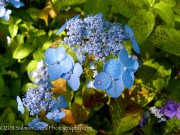
A sterling, highly sought after progeny of renown horticulturist and Hydrangea expert Michael Haworth-Booth’s breeding efforts, this low growing Hydrangea lulls us with cool, light blue lacecaps. The central fertile flowers are encompassed and sometimes hidden by prominent serrated sepals that later transmute sea-green and lilac-purple in sumptuous, glimmering shades. Compact and closely set, red-dashed green stems shape its attractive dwarf frame, while launching a fiery autumnal pageant of purple-rimmed, cardinal-colored leaves soon after the prolific blooms begin to fade.
Blooms July–September.
Size: 4' 0" high x 4' 0" wide.
Hardy to zone 6.
Exquisite long blooming lacecaps, whose flowers uniquely turn upside down and reveal pink undersides in late summer, plus brilliant copper red foliar fall colors are ‘Bluebird’s claim to fame. The robust, yet slow growing compact habit is defined by large pointy dark green leaves, unspotted stems and flattened gossamer-like bluish mauve inflorescences, presenting clustered rich blue fertile blossoms and 4 rounded sepals, which create the shape of a cross. Ideal as a deciduous container subject, this cold-hardy AGM recipient exhibits the bluest floral coloration in acidic soil and looks spectacular either en masse or positioned singularly on the fringes of a woodland garden.
Blooms June–October
Size: 3' 0" – 5' 0" high x 3' 0" – 5' 0" wide.
Hardy to zone 6.
Hydrangea serrata ‘Kiyosumi’ (S-0657)
Each $17.50
Straight from the slopes of Japan’s Mt. Kiyosumi comes this spectacular deciduous Hydrangea acclaimed for its classy pink lacecaps and lavish burgundy and henna-flushed new growth. Springing from ruby-red buds, the rosy picotee sterile florets are narrowly rimmed in red and eventually fade to white atop a compact rounded bushy habit. Broad mature dark green foliage that’s highlighted with prominent veins garbs the purple spotted stems. Medium sized and undemanding, ‘Kiyosumi’ lends dazzling accents to any shady spot, especially when planted behind Parahebe linifolia.
Blooms July–September
Size: 4' 0" high x 4' 0" wide.
Hardy to zone 6.
Hydrangea serrata ‘Miranda’ (S-0631)
Each $17.50

With unmatched delicacy, these exquisite inflorescences are defined by loosely spaced sepals wreathing around several separate, distinctive clusters of light blue, centrally arranged fertile flowers. The lacy, long lasting drama unfolds in varying shades from soft blue and mauve to nearly white to pale pink, sometimes donning streaks and swathes of different colors, depending upon the pH. Yellow-tinged green foliage attires this small-sized Hydrangea, and come autumn tints of claret warm the margins, veins and eventually the entire leaf.
A seedling selected by M. Haworth-Booth, ‘Miranda’s diminutive profile can be spotlighted in a patio vessel or anywhere its elegance is easily appreciated.
Blooms July–September.
Size: 3-1/2' – 4' 0" high x 3-1/2' – 4' 0" wide.
Hardy to zone 6.
Selected by the late great plantsman J. C. Raulston, this rare Japanese cultivar boasts dainty lacecaps with lilac or pink-blushed white florets poised upon a mesmerizing mound of gold-dusted green deciduous foliage. Pink petioles and striking maroon and red fall colors further highlight the extraordinary 5 in. long variegated leaves. Named after the sweet tasting amacha, a Japanese tea crafted from its dried leaves, ‘O Amacha Nishiki’ is a small-statured star specimen that’s well-suited for a mixed planting. It appreciates rich adequately-moist soil and protection from harsh afternoon sun inland, though tolerates full sun near the coast.
Blooms July–September
Size: 3-1/2' – 4' 0" high x 3-1/2' – 4' 0" wide.
Hardy to zone 6.
 A printed copy of them will be available upon request.
A printed copy of them will be available upon request.












